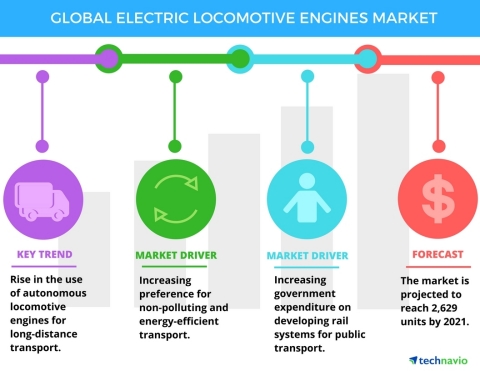LONDON--(BUSINESS WIRE)--Technavio’s latest report on the global electric locomotive engines market provides an analysis of the most important trends expected to impact the market outlook from 2017-2021. Technavio defines an emerging trend as a factor that has the potential to significantly impact the market and contribute to its growth or decline.
Praveen Kumar, a lead analyst from Technavio, specializing in research on powertrain sector, says, “Increasing concerns regarding emissions from diesel-electric locomotive engines drive governments to upgrade their rail transport systems to electric locomotives. China, India, and Russia are the key markets for electric locomotives.”
Electric locomotive engines are mainly preferred as they reduce road congestion caused by large freight trucks. They are an effective and non-polluting means of freight transport and they further reduce the dependence on petroleum-based fuel. Electric locomotive engines also decrease the frequency of trips required for transporting freight and passengers as these can travel at higher speeds than conventional diesel locomotive engines.
Looking for more information on this market? Request a free sample report
Technavio’s sample reports are free of charge and contain multiple sections of the report including the market size and forecast, drivers, challenges, trends, and more.
The top three emerging trends driving the global electric locomotive engines market according to Technavio automotive research analysts are:
Emergence of dual-mode locomotive trains
Annually, about USD 3 billion worth fuel is used in India for powering the diesel locomotives of the country. The Indian government plans to electrify about 22,000 miles of rails and introduce electric engine locomotives to reduce the dependence on diesel engines.
“The Indian Railways must acquire about 5,000 electric engine locomotives for complete electrification of rails. The additional cost of hiring engineers, additional skilled workforce and re-educating the existing staff about the operations of maintaining traction and locomotive maintenance for electric engines will be high,” according to Praveen.
Use of autonomous locomotive engines for long-distance transport
A large number of autonomous locomotives are used in underground rails for transporting passengers. The majority of these locomotives are automated and can travel short distances in metros and cities.
A centralized controller and a predefined railroad infrastructure are the main components that enable the intelligent movement of autonomous locomotive engines in metros and cities. However, long-distance autonomous transport requires sensors and self-driving algorithms (similar to those used in self-driving cars) embedded in the locomotives.
Emergence of hydrogen-powered locomotive engines
In 2016, ALSTOM, a locomotive engines manufacturer launched Coradia iLint, a hydrogen cell-powered passenger train. This train does not require overhead electric cables for power and does not cause pollution. The train is fueled by hydrogen that is placed on the roof of the train and produces electric energy by mixing hydrogen and oxygen.
This system emits only condensed water and steam as by-products. Since these trains run on hydrogen, they do not require expensive infrastructural changes (such as electrification of rails).
The key vendors are as follows:
- ALSTOM
- China CNR
- Siemens
Browse Related Reports:
- Global Automotive High-Pressure Fuel Pump Market 2017-2021
- Global Automotive Air Filter Market 2017-2021
- Global Automotive Dual Variable Valve Timing Market 2017-2021
Become a Technavio Insights member and access all three of these reports for a fraction of their original cost. As a Technavio Insights member, you will have immediate access to new reports as they’re published in addition to all 6,000+ existing reports covering segments like automotive components, automotive electronics, and automotive services. This subscription nets you thousands in savings, while staying connected to Technavio’s constant transforming research library, helping you make informed business decisions more efficiently.
About Technavio
Technavio is a leading global technology research and advisory company. The company develops over 2000 pieces of research every year, covering more than 500 technologies across 80 countries. Technavio has about 300 analysts globally who specialize in customized consulting and business research assignments across the latest leading edge technologies.
Technavio analysts employ primary as well as secondary research techniques to ascertain the size and vendor landscape in a range of markets. Analysts obtain information using a combination of bottom-up and top-down approaches, besides using in-house market modeling tools and proprietary databases. They corroborate this data with the data obtained from various market participants and stakeholders across the value chain, including vendors, service providers, distributors, re-sellers, and end-users.
If you are interested in more information, please contact our media team at media@technavio.com.




